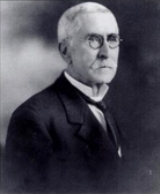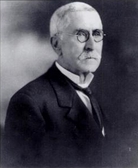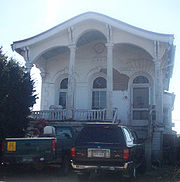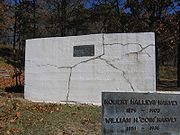
William Hope Harvey
Encyclopedia

.jpg)
Bimetallism
In economics, bimetallism is a monetary standard in which the value of the monetary unit is defined as equivalent both to a certain quantity of gold and to a certain quantity of silver; such a system establishes a fixed rate of exchange between the two metals...
and the health resort he built in Northwest Arkansas, Monte Ne
Monte Ne
Monte Ne is an area in the Ozark hills of the White River valley east of Rogers on the edge of Beaver Lake in the U.S. state of Arkansas. From 1901 until the mid-1930s the area was a health resort and ambitious planned community. It was owned and operated by William Hope Harvey, a financial...
. His enthusiasm for silver money was later incorporated into the both the Democratic and the American Populist Party in the early 1890s.
Childhood
He was born in Buffalo, West VirginiaBuffalo, West Virginia
Buffalo is a town in Putnam County, West Virginia, along the Kanawha River. The population was 1,236 at the 2010 census.-Geography:Buffalo is located at .According to the United States Census Bureau, the town has a total area of...
on August 16, 1851, the fifth child of six born to Robert and Anna Harvey. His father, Robert Trigg Harvey, was a Virginian of Scottish and English ancestry, and his mother, who had Virginian ancestors traceable to colonial times, was descended from French ancestors who had long since peopled the territory around nearby Gallipolis, Ohio
Gallipolis, Ohio
As of the census of 2000, there were 4,180 people, 1,847 households, and 1,004 families residing in the village. The population density was 1,156.2 people per square mile . There were 2,056 housing units at an average density of 568.7 per square mile...
.
Almost nothing is known of William Harvey's childhood except that it was disturbed by conflict between the Unionist
Union (American Civil War)
During the American Civil War, the Union was a name used to refer to the federal government of the United States, which was supported by the twenty free states and five border slave states. It was opposed by 11 southern slave states that had declared a secession to join together to form the...
majority in his region and secessionist
Confederate States of America
The Confederate States of America was a government set up from 1861 to 1865 by 11 Southern slave states of the United States of America that had declared their secession from the U.S...
sympathizers, among whom were some of his paternal relatives. He had one sister who joined a convent and a brother who died under the command of Robert E. Lee
Robert E. Lee
Robert Edward Lee was a career military officer who is best known for having commanded the Confederate Army of Northern Virginia in the American Civil War....
in the American Civil War
American Civil War
The American Civil War was a civil war fought in the United States of America. In response to the election of Abraham Lincoln as President of the United States, 11 southern slave states declared their secession from the United States and formed the Confederate States of America ; the other 25...
.
Education
He was educated at the Buffalo Academy. At the age of 16 he taught school for three months. He then attended Marshall CollegeMarshall University
Marshall University is a coeducational public research university in Huntington, West Virginia, United States founded in 1837, and named after John Marshall, the fourth Chief Justice of the United States....
at Guyandotte, Virginia
Huntington, West Virginia
Huntington is a city in Cabell and Wayne counties in the U.S. state of West Virginia, along the Ohio River. Most of the city is in Cabell County, for which it is the county seat. A small portion of the city, mainly the neighborhood of Westmoreland, is in Wayne County. Its population was 49,138 at...
for three months. At the time the college was teaching mostly secondary subjects. Then at age 17 he taught school for another three months. Afterward he ended his formal teaching and education, however he continued studying law with his brother Thomas, who would go on to graduate from Washington College
Washington and Lee University
Washington and Lee University is a private liberal arts college in Lexington, Virginia, United States.The classical school from which Washington and Lee descended was established in 1749 as Augusta Academy, about north of its present location. In 1776 it was renamed Liberty Hall in a burst of...
with a Bachelor of Law.
Law practice

West Virginia
West Virginia is a state in the Appalachian and Southeastern regions of the United States, bordered by Virginia to the southeast, Kentucky to the southwest, Ohio to the northwest, Pennsylvania to the northeast and Maryland to the east...
. He then opened up a law practice in Barboursville
Barboursville, West Virginia
Barboursville is a village in Cabell County, West Virginia, United States. It is located near the second largest city in the state, Huntington. The population was 3,183 at the 2000 census....
, and was relatively successful. He had a good court appearance being slender, five foot ten, erect bearing and penetrating blue eyes. He was soon practicing law in Illinois and Ohio.
Early in his career, he took a case that no other attorney would. He defended a white man
White people
White people is a term which usually refers to human beings characterized, at least in part, by the light pigmentation of their skin...
who married an African American
African American
African Americans are citizens or residents of the United States who have at least partial ancestry from any of the native populations of Sub-Saharan Africa and are the direct descendants of enslaved Africans within the boundaries of the present United States...
woman, which was against the law in West Virginia. To close his defense Harvey asked, "Can anyone in this courtroom prove that this man has not a drop of colored blood in his veins." The case was dismissed.
Another case he had seems to have profoundly impacted him for the rest of his life. Harvey was representing a wealthy client who was the victim of a murder. From then on he mistrusted great wealth. He developed a strong belief in the coining of money with silver at 1/16 the cost of gold. This would increase employment in silver mines and bring people out of debt. He hated usury
Usury
Usury Originally, when the charging of interest was still banned by Christian churches, usury simply meant the charging of interest at any rate . In countries where the charging of interest became acceptable, the term came to be used for interest above the rate allowed by law...
, and the practice of charging interest on loans. These views earned him the nickname "Coin".
Family
Three years after opening his law practice, Harvey moved to Huntington, West VirginiaHuntington, West Virginia
Huntington is a city in Cabell and Wayne counties in the U.S. state of West Virginia, along the Ohio River. Most of the city is in Cabell County, for which it is the county seat. A small portion of the city, mainly the neighborhood of Westmoreland, is in Wayne County. Its population was 49,138 at...
and became law partners with his brother Thomas. Then in 1873 he moved forty miles to Gallipolis
Gallipolis, Ohio
As of the census of 2000, there were 4,180 people, 1,847 households, and 1,004 families residing in the village. The population density was 1,156.2 people per square mile . There were 2,056 housing units at an average density of 568.7 per square mile...
. Here he met Anna Halliday and they were married June 26, 1876. Later that year they moved to Cleveland
Cleveland, Ohio
Cleveland is a city in the U.S. state of Ohio and is the county seat of Cuyahoga County, the most populous county in the state. The city is located in northeastern Ohio on the southern shore of Lake Erie, approximately west of the Pennsylvania border...
. While they were living there they had two children: Mary Hope and Robert Halliday. Then in 1879 the moved to Chicago
Cleveland, Illinois
Cleveland is a village outside the Quad Cities in Henry County, Illinois, United States. The population was 188 at the 2010 census, down from 253 at the 2000 census.-Geography:Cleveland is located at ....
where they had a third child Thomas William. Finally in 1881 the Harveys moved back to Gallipolis.
Harvey was the campaign manager for William Jennings Bryan
William Jennings Bryan
William Jennings Bryan was an American politician in the late-19th and early-20th centuries. He was a dominant force in the liberal wing of the Democratic Party, standing three times as its candidate for President of the United States...
's 1896 Presidential run
United States presidential election, 1896
The United States presidential election held on November 3, 1896, saw Republican William McKinley defeat Democrat William Jennings Bryan in a campaign considered by political scientists to be one of the most dramatic and complex in American history....
. Bryan lost 271 to 176 in the electoral college.

Harvey established the Ozark Trails Association
Ozark Trails Association
The Ozark Trails Association were a group of private citizens that tried to encourage local municipalities to build and maintain road systems in the Ozarks in the early 20th century. It was established in 1913. They erected large obelisks marking the various roads and indicated distances to...
to promote good roads, highway markers, and maps. Although his main interest was promoting travel to Monte Ne, in southwest Missouri
Missouri
Missouri is a US state located in the Midwestern United States, bordered by Iowa, Illinois, Kentucky, Tennessee, Arkansas, Oklahoma, Kansas and Nebraska. With a 2010 population of 5,988,927, Missouri is the 18th most populous state in the nation and the fifth most populous in the Midwest. It...
and across Oklahoma
Oklahoma
Oklahoma is a state located in the South Central region of the United States of America. With an estimated 3,751,351 residents as of the 2010 census and a land area of 68,667 square miles , Oklahoma is the 28th most populous and 20th-largest state...
, the Texas
Texas
Texas is the second largest U.S. state by both area and population, and the largest state by area in the contiguous United States.The name, based on the Caddo word "Tejas" meaning "friends" or "allies", was applied by the Spanish to the Caddo themselves and to the region of their settlement in...
panhandle, and on into New Mexico
New Mexico
New Mexico is a state located in the southwest and western regions of the United States. New Mexico is also usually considered one of the Mountain States. With a population density of 16 per square mile, New Mexico is the sixth-most sparsely inhabited U.S...
. Much of this route became the famed U.S. Route 66
U.S. Route 66
U.S. Route 66 was a highway within the U.S. Highway System. One of the original U.S. highways, Route 66 was established on November 11, 1926 -- with road signs erected the following year...
.
In his later years, as Monte Ne began to sink into debt and his health began deteriorating, he believed that human civilization was on the verge of collapse. He began making plans to build a giant obelisk
Obelisk
An obelisk is a tall, four-sided, narrow tapering monument which ends in a pyramid-like shape at the top, and is said to resemble a petrified ray of the sun-disk. A pair of obelisks usually stood in front of a pylon...
, although he referred to it as 'The Pyramid
Pyramid
A pyramid is a structure whose outer surfaces are triangular and converge at a single point. The base of a pyramid can be trilateral, quadrilateral, or any polygon shape, meaning that a pyramid has at least three triangular surfaces...
'. It was serve as a time capsule for future humans to see what society had been like at its peak. Although some preliminary work on the Pyramid was done, Harvey became preoccupied with building an amphitheater which used up most of his funds and after the stock market crash of 1929 all work at Monte Ne ceased and the Pyramid was never constructed.
In 1932 Harvey formed the Liberty Party
Liberty Party (1930s)
The Liberty Party was a minor political party in the United States in the 1930s, based on the economic theories of W.H. "Coin" Harvey . Harvey was initially its 1932 presidential candidate, and they held their convention at his resort, Monte Ne...
based on his financial theories.
Books and writings
- Coin's Financial SchoolCoin's Financial Schoolright|thumbCoin's Financial School was a popular pamphlet written in 1893 that helped popularize the free silver and populist movements. The author of the text "Coin", William Hope Harvey, would later go on to aid William Jennings Bryan in his bid for the presidency and would run for the presidency...
(1893) - A Tale of Two Nations (1894)
- The Patriots (1895)
- Coin on Money, Trusts, and Imperialism (1899)
- The Remedy (1915)
- Common Sense (1920)
- Paul's School of Statesmanship (1924)
- The Book (1929)
- Coin's Financial School Up To Date
- Common Sense, Or The Clot On The Brain Of The Body Politic
External links
- Restoring the Historic Coin Harvey House of Huntington, West Virginia at coinharvey.com
- AmericanHeritage.com / William Hope Harvey at www.americanheritage.com Entry at AmericanHeritage.com

